How to Fix as well as Avoid Bathroom Water Damage
How to Fix as well as Avoid Bathroom Water Damage
Blog Article
Presented here down the page you will find additional professional material relating to How to Repair and Prevent Bathroom Water Damage.

The bathroom is very vulnerable for damp accumulation as well as possible water damage because of the frequent use of water in it. This write-up provides basic inspection methods to aid spotting water damages hazards.
The regular use water in the bathroom makes it exceptionally susceptible for wet accumulation and also potential water damages. By evaluating it frequently, you can lower water associated problems.
The following collection of examinations is easy to do and also ought to be done as soon as in every three months in order to keep your washroom in good shape as well as to stop potential water damages brought on by the bathtub, the shower, pipe joints and also plumbing, sinks, cabinets, as well as the commode
Do not neglect carrying out these assessments and also be thorough while doing them. Remember that these simple evaluations can conserve you a great deal of money by offering early signs for water damages
Sinks and Cabinets
Sinks and cabinets are revealed to moisture and humidity everyday and also are often neglected. Check consistently under the sink and on the countertop above it. Repair any type of drip in the catch as it might recommend drain problems. Take a look around the sink, sluggish draining pipelines might show an obstructed drain. Replace sink seals if they are broken or loose.
Tub as well as Shower
The shower as well as bath tub call for unique focus and also maintenance. Check the tiles and replace if broken. Ensure that there is no missing grout between the tiles. Inspect and replace cracked caulking at joints where the walls fulfill the flooring or the tub. Blocked drains and pipelines troubles will certainly avoid the bathtub from drying out and might show severe issues beneath the tub. Speak with an expert right away to stop structural damages. Take notice of discolorations or soft locations around the bath tub walls as they may show an interior leak.
Plumbing
Signs for water damage are tough to discover because most pipelines are set up inside the walls.
Pay unique interest to flooring and also walls dampness and discolorations as they may show an undetectable plumbing problem. Inspect moisture degrees in adjoining spaces as well.
The Bathroom
The commode is an at risk water junction. Examine the water lines as well as look for leaks around the commode seat, in the hose, as well as under the water tank. If you discover any indications of dampness on the floor around the commode, look for leaks in the toilet rim and also tank seals.
Know that hanging commode bowl antiperspirants increases the possibilities for obstructions.
TIPS TO PREVENT WATER DAMAGE IN THE BATHROOM
The average household uses approximately 80-100 gallons of water per person per day. For a family of 4, that's almost 2,500 gallons of water a week! The largest portion of this consumption comes from bathroom use. Flushing the toilet uses the most water, followed by taking a shower or bath. With that much water running through the home, water damage in the bathroom is bound to happen. Knowing how to spot signs of a water leak is essential to preventing long-term damage. This guide provides you with tips to reduce the impact of water damage on your bathroom.
CAUSES OF BATHROOM WATER DAMAGE
Pipe breaks are the most common cause of water damage we see in our daily jobs. The age of a pipe plays a large role in a pipe break as well as corrosion. Over time, the metal begins to break down, allowing water to escape. Frozen pipe breaks are also a concern in the winter months. Toilet overflows caused by paper products or children flushing inappropriate items. Degraded caulking around the toilet or bathtub can allow water seepage, sometimes behind the fixture, into the subfloor or walls. Condensation forms when the water in a pipe is cooler than the air temperature. Beads of water form on the exterior of the pipes, sometimes so much so that the water begins to drip and pool below. Sink or shower backups created by poor drainage. HOW TO PREVENT WATER DAMAGE IN YOUR BATHROOM
Inspect your toilet supply line for worn or frayed hoses and replace them as needed. Winterize your plumbing to prevent a frozen pipe break. Use vent fans to prevent condensation that can lead to mold growth. Routinely check and replace degraded caulking around your toilet or bathtub. Increase the temperature in your toilet tank and insulate your pipes during the warm summer months to keep condensation from forming. Use child safety locks on the toilets. Flush only toilet paper. "Flushable" wet wipes are actually not good for your plumbing system. Additionally, feminine hygiene products should not be flushed. Prevent water from escaping the tub or shower. Make sure shower curtains are in good condition. Inspect shower doors and replace the seal strip if necessary. Wipe up any water that accumulates on the floor and use bath mats. Water left to sit can cause damage to the tiles and flooring. Refrain from using bath products containing heavy oils to avoid a clogged drain.

As a devoted person who reads about Looking for Signs of Water Damage in the Bathroom, I think sharing that short article was really helpful. If you enjoyed reading our blog entry if you please do not forget to share it. Thanks for your time. Visit us again soon.
Source This Article Report this page